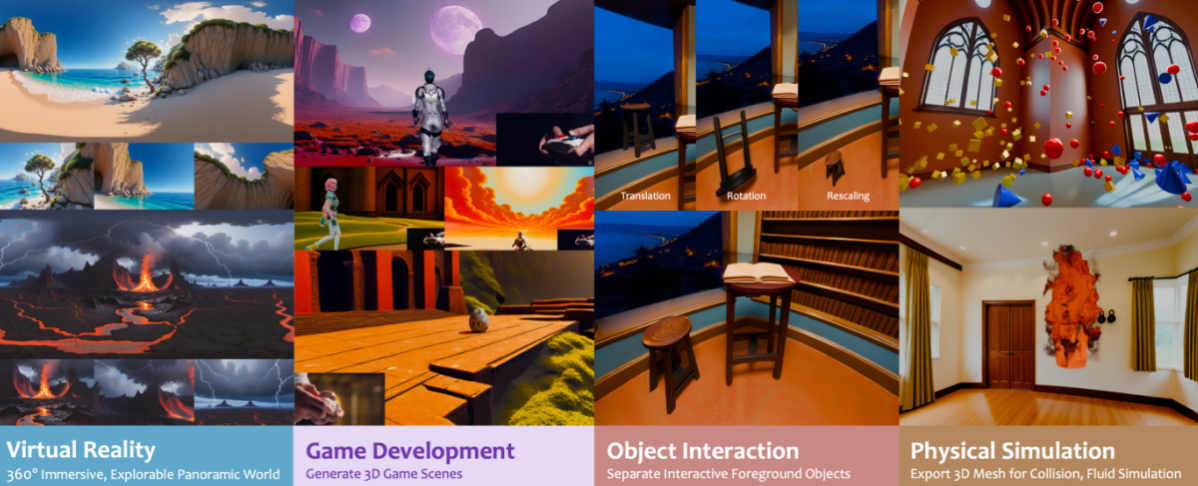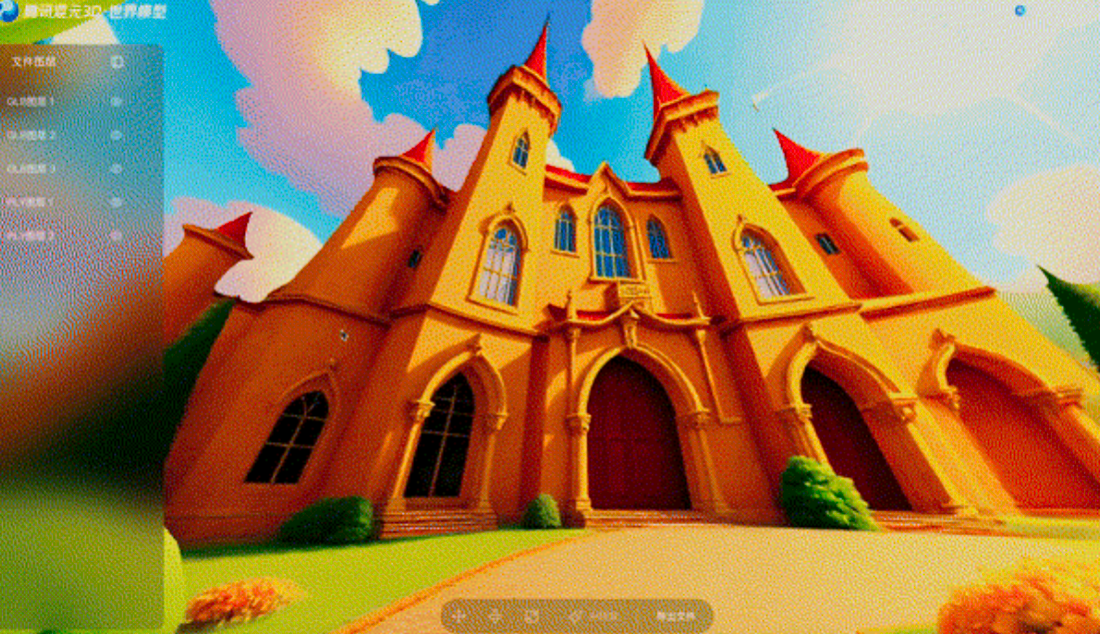Tencent Unveils Open-Source Hunyuan 3D Model 1.0: What Business Secrets Lie Beneath?
![]() 08/01 2025
08/01 2025
![]() 562
562

In July 2025, amidst the buzz of the World Artificial Intelligence Conference (WAIC) in Shanghai, Tencent made a groundbreaking announcement: the official release of Hunyuan 3D World Model 1.0, immediately followed by its decision to fully open-source the technology.
This is not merely another "text-to-video" technological marvel; it is a colossus capable of generating complete, navigable, interactive, and editable 3D worlds from a single sentence or image in mere minutes.
Some have likened it to the "Minecraft of the generative AI field," but perhaps this analogy falls short. It is more akin to a comprehensive suite of world-creation tools, democratizing the ability to "build worlds" that was once the exclusive domain of top game studios and CG teams to developers worldwide in an unprecedented manner.
When an industry giant chooses to "reveal" such a core technology to the public, admiration for its generated effects is just the tip of the iceberg. Behind this move lies a meticulously chosen technological path and a closely aligned commercial strategy.
As a highlight of this release, Tencent's Hunyuan 3D World Model 1.0 integrates panoramic vision generation and layered 3D reconstruction technology, supporting both text and image inputs, enabling the creation of high-quality, stylistically diverse, navigable 3D scenes.
What once required weeks of work by a professional modeling team to build a 3D virtual world can now be accomplished in minutes from a single sentence of text or an image.
Achieving "world generation" presents two major technical challenges: scarce and expensive pure 3D training data, and the immense computational and memory overhead of 3D representation. Directly generating content in 3D space through brute force is neither economically nor efficiently viable.
In response, the Hunyuan team adopted a highly pragmatic fusion solution, whose technical architecture can be summarized as a clever "two-stage" generation paradigm.
Stage 1: Compression and Representation of the 3D World (3D-aware VAE)
First, the model learns to "understand" a 3D world. The research team trained a custom 3D-aware Variational Autoencoder (VAE).
This VAE's task is to encode (compress) vast, high-precision, structurally complex 3D scene data into a latent space representation that is significantly lower in dimension but rich in information. This process is akin to distilling a thick encyclopedia into a few pages of precise summaries.
This "summary" (i.e., latent encoding) retains the core geometric, textural, and stylistic information of the original 3D world, laying a solid foundation for subsequent generation steps.
Stage 2: Diffusion Generation in Latent Space (Diffusion Transformer)
With a high-quality latent space in place, the real "creation" process begins.
The research team trained a state-of-the-art diffusion model (Diffusion Model) on this latent space, leveraging the powerful Transformer architecture (i.e., DiT, Diffusion Transformer) as its backbone network.
Its working principle can be colloquially understood as "sculpting from chaos to order." Starting from a completely random noise latent encoding, guided by the semantics of text or image prompts, the model gradually sculpts this random noise into a meaningful, user-compliant, brand-new 3D world latent encoding through a multi-step "denoising" process.
Finally, this new latent encoding generated by DiT is sent to the decoder of the first-stage VAE, where it is "decompressed" and restored, ultimately constructing the complete, tangible 3D world visible to the user.
What is even more remarkable is that the most exciting aspect of Hunyuan 3D World Model 1.0 is not just the visual effects of the generated worlds but also its three key characteristics, marking a decisive shift in AI-generated content from "exhibits" to "productivity tools".
Navigable: The generated scene is not a static "skybox"; users can freely move within it using a keyboard and mouse. This paves the way for applications such as game prototypes, VR experiences, and virtual tourism.
Editable: Thanks to semantic layering technology, foreground objects and backgrounds are separated. Developers can import the generated standard 3D mesh files into mainstream software like Unity, Unreal Engine, or Blender to move, scale, replace, or even delete individual objects, seamlessly integrating AIGC content with traditional CG workflows.
Simulatable: This is one of its most far-reaching potentials. Since objects in the scene are independent 3D assets, developers can assign physical properties to them for dynamic simulation. This means that what is generated is not just a static set but a miniature world capable of responding to physical laws.
These three characteristics collectively point to a core value: industrial-grade usability.
Tencent's aim is clearly not to create a toy but to build a powerful tool that can seamlessly integrate into content creators' production pipelines.
 (Generation Interface Demonstration: Generated 3D Scene Assets are Editable)
(Generation Interface Demonstration: Generated 3D Scene Assets are Editable)
Simultaneously releasing and open-sourcing such a heavyweight model is undoubtedly a bold strategic declaration. To understand the deeper implications of Tencent's move, it must be examined within the broader context of its AI strategic blueprint.
At WAIC, Tencent unveiled its comprehensive "1+3+N" AI application landscape for the first time.
"1" Core Engine: Based on Tencent's self-developed Hunyuan large model.
"3" Platform Capabilities: The intelligent agent platform "Tencent Yuanqi" for C-end users, the "Tencent Cloud Intelligent Agent Development Platform" for B-end enterprises, and the embodied intelligence open platform "Tairos" for the robotics industry.
"N" Application Matrix: AI agents covering office, life, enterprise services, and other scenarios, as well as eco-products deeply integrated with AI capabilities such as WeChat, QQ, and Tencent Games.
In this system, Hunyuan 3D World Model 1.0 plays a role far beyond just a model. It is the pinnacle manifestation of multimodal capabilities in the "1" and a key infrastructure enabling the "3" and "N".
For games, it can drastically shorten the scene construction cycle; for embodied intelligence, it provides a low-cost, high-efficiency physical simulation environment; for C-end applications, it fuels a steady stream of content for VR/AR social interactions and virtual space experiences.
 (Demonstration of Physical Simulation Applications)
(Demonstration of Physical Simulation Applications)
Tencent's open-source strategy is not purely altruistic but a higher-dimensional commercial competition tactic.
First, preempt standards and define the future.
On the cusp of the 3D AIGC technology explosion, whoever can provide the most user-friendly and powerful open-source toolchains will set the "rules of the game" in this field. Through open-sourcing, Tencent aims to make the architecture, data format, and workflow of Hunyuan 3D World Model 1.0 de facto industry standards, attracting global developers to innovate around it.
Second, ecological empowerment and traffic feedback.
Tencent's core advantage lies in its vast application ecosystem, particularly in gaming and social networking. By providing a powerful 3D world generation tool for free, it can significantly invigorate the vitality of small and medium-sized developers and content creators.
The content created by these developers using Tencent's tools will most likely be published on Tencent's platforms (such as WeChat Mini Games, QQ Channels, VR App Stores, etc.), thereby feeding back and thriving its main business. Clearly, this is a strategy of "teaching people to fish and building a pond together."
Third, community-driven, accelerated iteration.
Open-sourcing harnesses the wisdom of global developers. The power of the community can help the model identify issues, fix bugs, develop plugins, and expand application scenarios faster, iterating at a speed far surpassing that of closed-source teams. This is crucial in the rapidly evolving field of AI.
Last, lower the threshold and activate the industry.
The high threshold for 3D content creation has always been an industry pain point. Open-sourcing Hunyuan 3D World Model 1.0 allows independent game developers or small studios to possess scene generation capabilities comparable to large companies. This will spawn a multitude of games and applications that were previously unfeasible due to cost issues, thereby expanding the entire 3D content industry pie, and as the platform provider, Tencent will naturally benefit from it.
Globally, AI giants take different paths in their model strategies.
OpenAI's GPT series and Sora have moved towards a highly closed business model, profiting through API calls; while Meta's Llama series has firmly chosen the open-source route, attempting to challenge OpenAI's leading position through an open community.
Tencent's choice in the 3D world model this time is clearly closer to Meta's philosophy but with its own unique "Tencent characteristics".
Unlike pure technology companies, Tencent has robust content distribution channels and application scenarios. Its open-source strategy is not just to promote the technology itself but to arm its vast ecosystem. This gives its open-sourcing an additional layer of closed-loop logic of production and sales integration compared to other companies.
When developers use Hunyuan tools to create stunning VR worlds, they will find that the most convenient option is to publish them with one click to VR platforms cooperating with Tencent. This seamless integration is precisely the ecological barrier that Tencent hopes to build and that is difficult to replicate.
In our view, the release and open-sourcing of Tencent's Hunyuan 3D World Model 1.0 have far greater significance than a mere technology demonstration. It is a strategic move aimed at reshaping the landscape of the entire digital content ecosystem by unleashing 3D content productivity.
By putting this cutting-edge world-creation tool in the hands of global developers, Tencent is not only showcasing its technological prowess but also inviting creators worldwide to jointly populate and thrive in its vast application universe.
The AI-driven 3D content revolution has already begun. It may not immediately overthrow everything, but it has opened a door to a new world for game developers, VR dreamers, and digital artists.
As Tencent hopes, a "usable AI" is accelerating towards us from the distant horizon of technology, and this time, it brings the power to create entire worlds.
-END-
Source: @ChiefDigitalOfficer





